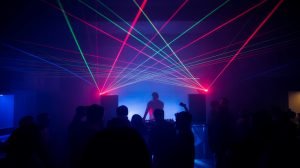Have you ever wondered what mysterious liquid is used to create the fog that fills up a room and creates an atmosphere of mystery?
If so, then this blog article is for you! In it, we will uncover the mystery behind fog machine liquids and explore different types of liquid used in these machines. We’ll also take a look at how fog machines create their mystical effects and delve into the science behind creating fog with specialized liquids.
So if you’re curious about what goes into making your favorite spooky effects, read on!
Fog machines are a popular way to create an eerie atmosphere for theatrical performances, parties, and other special events. But what liquid is used in these fog machines?
The answer depends on the type of fog machine you’re using. Most modern fog machines use water-based liquids that are specially formulated with glycol or glycerin as the main ingredient.
These liquids evaporate quickly when heated by the machine’s heating element and create a thick white smoke-like effect. Some manufacturers also add additional ingredients, such as fragrances or dyes, to enhance the effects of their products.
Dry ice is another option for creating fog effects without using any liquid at all! Dry ice is simply frozen carbon dioxide which can be placed into a container with hot water to produce an intense cold mist that looks like smoke but dissipates quickly without leaving any residue behind. This method is often used in haunted houses and other spooky settings where it adds an extra layer of eeriness to the atmosphere!
For those looking for something more permanent, oil-based afterward fluids can be used in some types of fog machines too – though this type of fluid tends to leave behind residue after it has been vaporized so it isn’t ideal if you want your environment clean afterward!
Oil-based fluids usually contain mineral oil along with additives such as alcohols or propylene glycol, which help keep them from becoming too viscous when heated up by your machine’s heating element before they turn into vapor form and disperse throughout your space, creating thick clouds of ‘fog.’
No matter what kind of liquid you choose, make sure that whatever product you buy comes from a reputable manufacturer who specializes in producing quality products specifically designed for use with their own brand-name equipment – this will ensure optimal performance while helping protect against potential damage caused by improper usage or incompatible chemicals being mixed together inside your unit itself!
Uncovering the Mystery of Fog Machine Liquids
Have you ever been to a concert or a party and noticed the mysterious fog that envelops the stage? Have you ever wondered what liquid is used in fog machines to create this effect?
Well, it turns out that there are several different types of liquids used in fog machines, each with its own unique properties. The most common type of liquid used in fog machines is glycol-based fluid.
Glycol is an organic compound made up of two parts: propylene glycol and ethylene glycol. This combination creates a thick, viscous substance that can be vaporized by heat from the machine’s heating element. The resulting vapor produces clouds of dense white smoke when mixed with air particles. Another type of fluid often found in modern-day fog machines is water-based fluid or “fog juice.”
This solution consists mainly of distilled water combined with other chemicals such as propylene glycol and/or triethylene glycol (TEG). When heated, these chemicals produce tiny droplets, which form clouds when they come into contact with cooler air particles outside the machine.
Finally, some manufacturers also use mineral oil-based fluids for their products due to their low cost and non-toxic nature compared to other fluids on the market today. Mineral oil-based solutions are typically composed primarily of paraffin waxes combined with various additives such as surfactants or emulsifiers for improved performance characteristics like increased viscosity or reduced flammability risk.
Regardless if you’re using one kind over another – all three types have one thing in common: they help create an amazing atmosphere at any event! So next time you see those magical clouds filling your venue – now you know what’s behind them!
What You Need to Know About the Liquid Behind Fog Machines
Fog machines are a great way to create an atmosphere for any event or occasion. Whether you’re hosting a Halloween party, creating the perfect ambiance for a wedding reception, or want to add some drama and mystery to your next movie night, fog machines can help you achieve the desired effect.
But what exactly is that mysterious liquid behind the fog? The answer is simple: water-based glycols. Glycols are organic compounds made up of carbon atoms linked together in long chains with hydroxyl groups attached at regular intervals along those chains.
When mixed with water and heated up by the fog machine’s heating element, these glycol molecules break down into tiny droplets that form clouds of vapor when they come into contact with cooler air outside the machine.
This vapor creates an artificial mist that gives off that eerie look we associate with spooky scenes from horror movies! Glycol-based fluids have been used in theatrical productions since as early as 1820. Still, it wasn’t until much later on in history (around 1950) that they began being used more widely for special effects purposes, such as creating smoke screens and other atmospheric effects like fogging out rooms during live performances or film shoots.
Today there are many different types of water-based glycol solutions available on the market specifically designed for use in modern-day fog machines – each one offering its own unique characteristics depending on how thick/dense you want your ‘fog’ to be!
Exploring Different Types of Liquid Used in Fog Machines
Exploring different types of liquid used in fog machines can be an exciting journey. From the traditional water-based fog to more advanced glycol and oil-based formulas, there are a variety of liquids that can be used to create unique effects for any occasion.
Water-based fog is the most common type of fluid used in fog machines, as it produces a thick white cloud with minimal residue or odor. Glycol-based fluids are often preferred when creating long-lasting clouds due to their slow evaporation rate and ability to produce thicker plumes than water-based solutions.
Oil-based fluids offer an even longer-lasting effect but tend to have a stronger smell and may leave behind an oily residue on surfaces they come into contact with. With so many options available, it’s important for anyone using these products to understand which type best suits their needs before making a purchase decision!
How Does a Fog Machine Create its Mystical Effects?
Fog machines are a great way to create an atmosphere of mystery and suspense. They produce a thick, white fog that can be used in theatrical performances, Halloween decorations, or even just for fun!
But how do these machines actually work? At the heart of every fog machine is a special liquid known as “fog juice.” This liquid is made up of water and glycol-based chemicals such as propylene glycol or triethylene glycol. When heated by the machine’s heating element, this mixture creates a vapor that then exits through the nozzle at high pressure.
As it passes through the air it cools down quickly and forms tiny droplets that make up what we know as “fog.” The size of these droplets determines how dense and long-lasting your fog will be – larger droplets dissipate faster, while smaller ones linger longer in the air before evaporating completely.
The combination of heat from the heating element and pressurized vapor from the nozzle creates an impressive effect when you turn on your fog machine – creating an eerie misty atmosphere with little effort! With some experimentation, you can find out what type of settings work best for different types of events or occasions to get exactly what you want out of your fog machine experience!
The Science Behind Creating Fogs with Specialized Liquids
Fog machines are a popular way to create an eerie atmosphere at special events, such as Halloween parties or haunted houses. But what is the science behind these mysterious devices?
In order to understand how fog machines work, it’s important to know what liquid is used in them. The most common type of liquid used in fog machines is glycerin-based smoke fluid. This specialized mixture contains propylene glycol and water, which, when heated, creates a thick white vapor that looks like fog.
The amount of propylene glycol determines the density of the vapor produced by the machine; more propylene glycol results in thicker clouds of “fog,” while less produces thinner ones.
However, there are other liquids that can be used for creating fogs with specialized effects, such as dry ice or mineral oil-based fluids, which produce low-lying ground fogs and even scented mists!
Dry ice-based fluids use carbon dioxide gas instead of heat to create their effect while mineral oil-based fluids contain hydrocarbons that evaporate quickly when exposed to air resulting in a dense cloud formation on contact with surfaces like floors and walls!
No matter what type of liquid you choose for your fog machine, it’s important to remember that all types require proper ventilation due to their potential health risks if inhaled over long periods without proper protection from respiratory masks or filters!
Please be careful and use at your own risk
None of the authors, contributors, administrators, or anyone else connected with Wild Fog, in any way whatsoever, can be responsible for your use of the information contained in or linked from these web pages.










